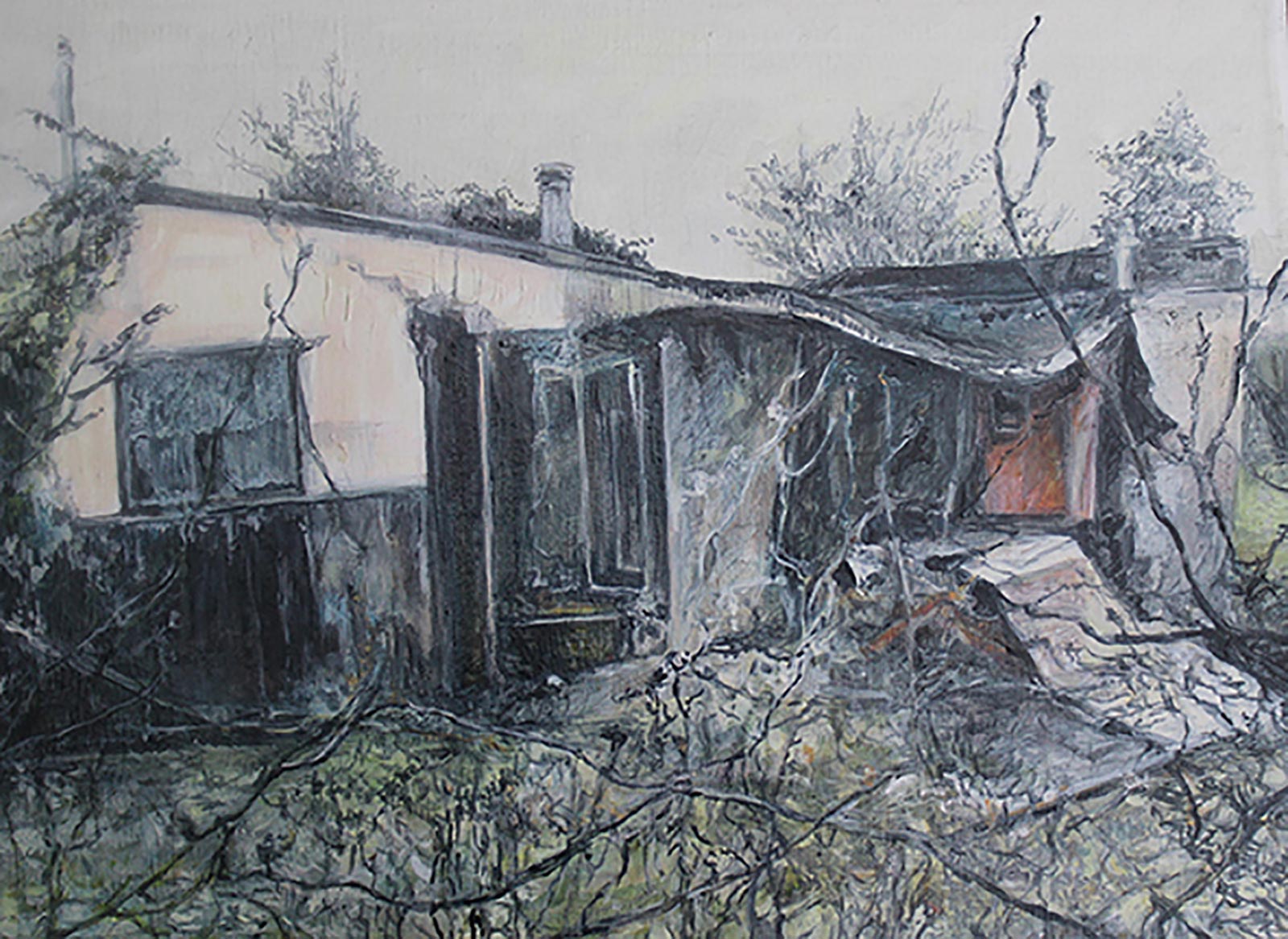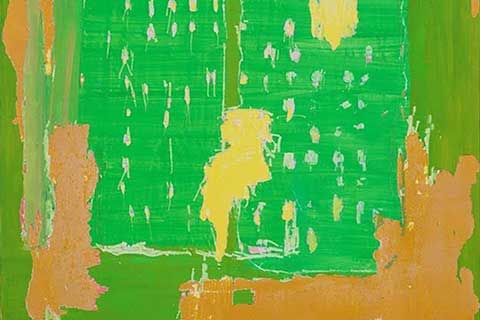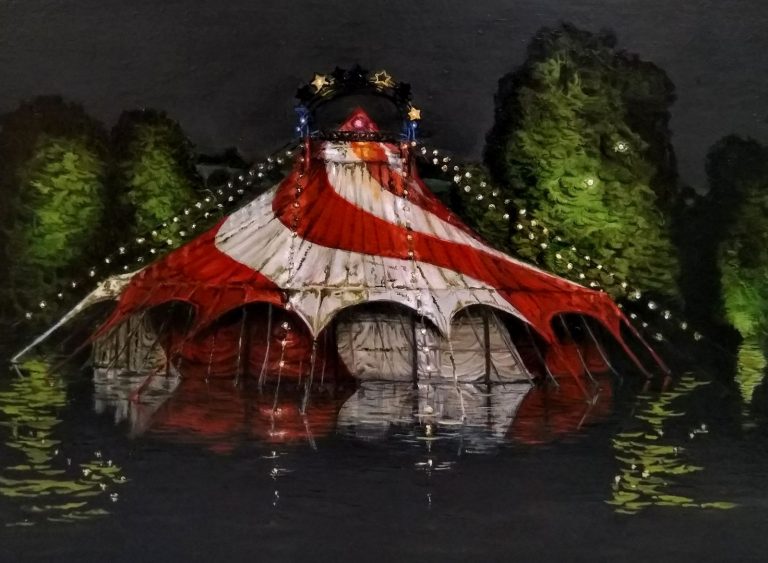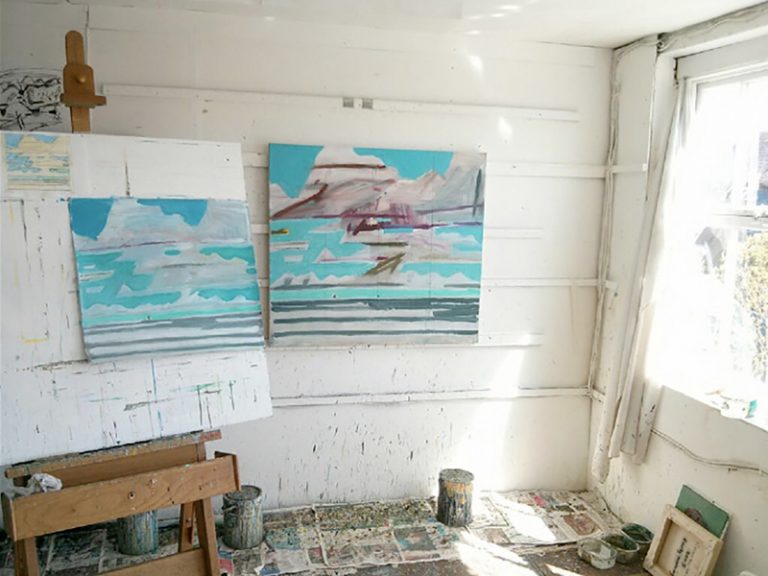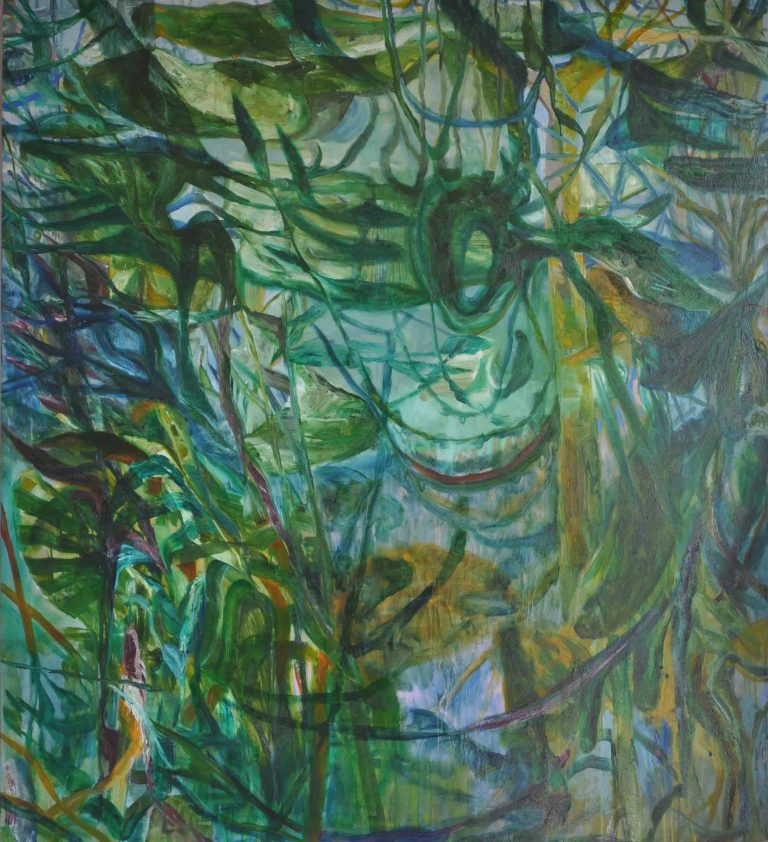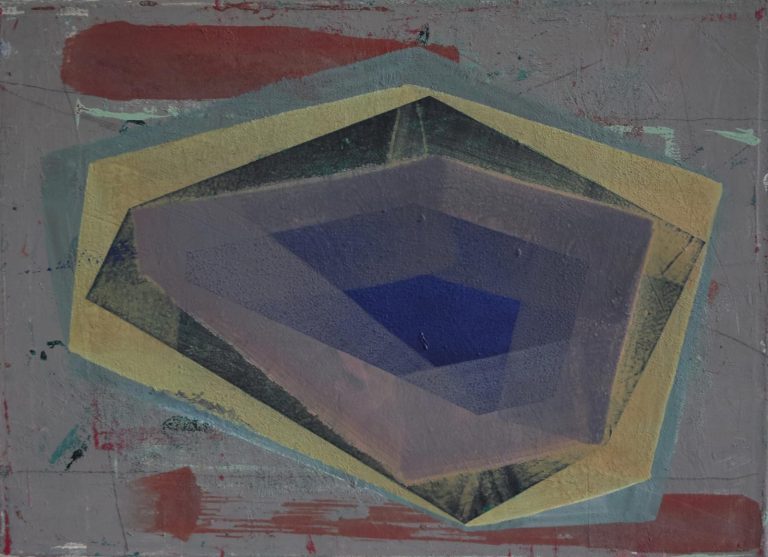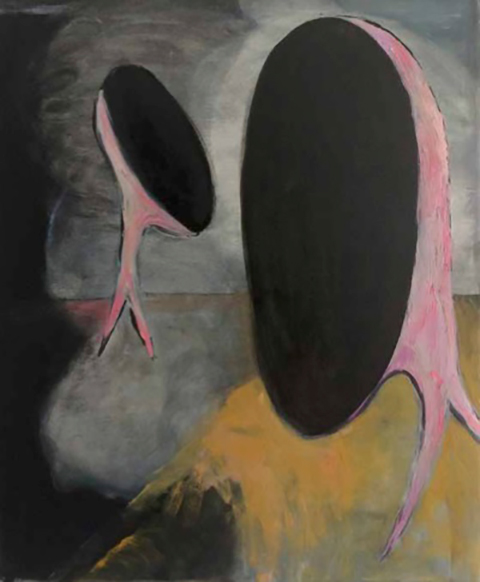British Painting in China
Essay by Dr Judith Tucker
To accompany the exhibition “Contemporary Masters from Britain: 80 British Painters of the 21st Century”, Judith Tucker of the University of Leeds explores the role of the tactile and ‘real’ work of art in an ‘unreal’ world.
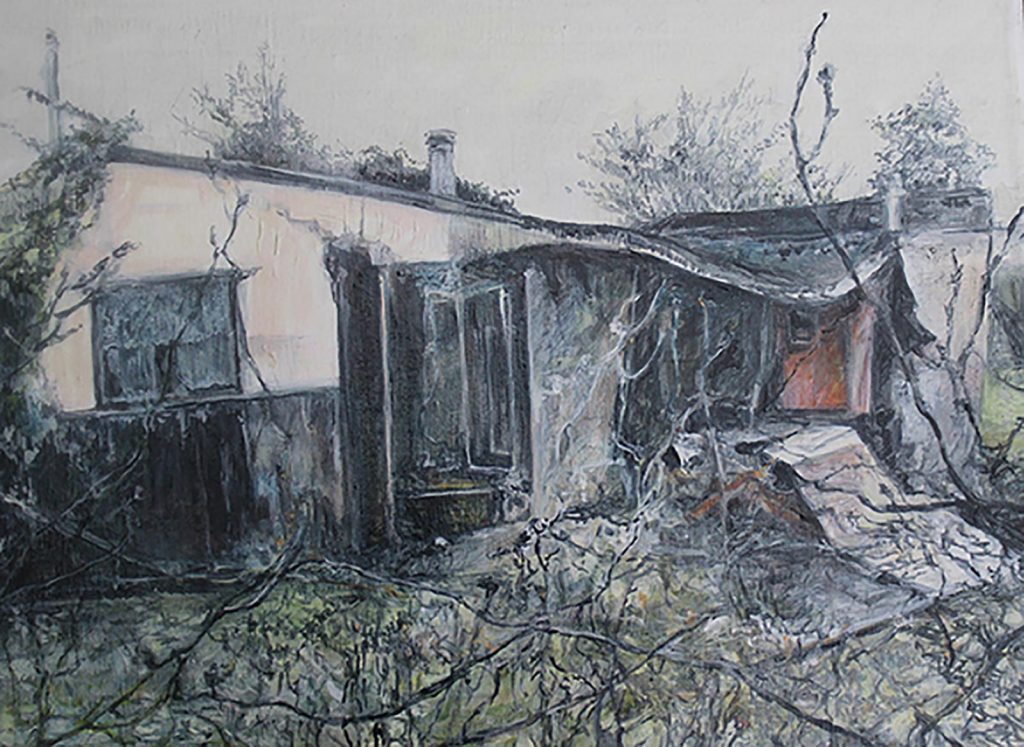
Between us: British painting in China
At the time of writing this essay all the British paintings for the exhibition are in transit: they are lying packed and carefully wrapped in their crate. They are somewhere, could be anywhere, on their five thousand miles long journey. The paintings have been made in all kinds of studios: from small domestic spaces to large industrial warehouses, some in the happening inner cities, some in the post-industrial edgelands of those cities, some in the relative quiet of what once might have been, and still just might be, a rural idyll. Scattered far and wide across our green and not always quite so pleasant land there are very many painters, very many people with the widest possible demographic, all committed to making sense of the world they inhabit through making marks on a surface. Painting and painters have demonstrated extraordinary staying power here. The paintings that result, of which those included in this group exhibition might be thought of as a representative sample, take on as diverse a variety of visual forms as the places they were made in, but all share integrity, vitality and a preoccupation with what painting can offer at the beginning of the twenty-first century. The exhibition’s strengthis precisely that it is eclectic, bringing together not only a mix of geographies and generations, but creating surprising visual and material juxtapositions. Nonetheless, what all the works share is a fascination with the act of making. Whatever the visual idiom they might employ many of the artists explore and exploit the shared, familiar languages of the historical theories and practices of painting, what André Rottman terms the
…closely related antagonisms – colour and contour, transparency and opacity, gesture and facture, illusion and flatness, semblance and objecthood, chroma and contrast, chance and composition, mark making and the monochrome, ostentatious virtuosity and anonymous execution, figuration and abstraction … (Rottman in Graw, 2013, p9)
Some of the painters work between moving and still imagery, between fleeting digital images and the stubborn materiality of paint, moving to and fro between painting and digital work and allowing aspects of each process to influence the other, offering opportunity to consider how new technology might have transformed painting. Others explore, to use David Joselit’s essay title, how Painting is beside itself. (2009) They are the sort of painterly works which explicitly visualise and establish relations with the wider networks of distribution and exhibition in which they are entangled those “practices in which painting sutures a virtual world of images onto an actual network composed of human actors, allowing neither aspect to eclipse the other”. (ibid, 129).
To return to our paintings, images in transit, on their way to be exhibited. Imagining the crate of paintings on its long journey to China not only addresses aspects of these networks to which Joselit refers, but in its very bulk emphasises the materiality, the thingness of these works. The anachronistic slowness of freight passage by sea in our fast-moving digital world offers us a pause for thought and reflection. The paintings have left those studios, where they were made, the paintings have left behind those who created them and they have not yet been seen in the gallery spaces of China. They are in between. Thinking of them as being so literally between places not only reminds me of vast global, social and economic networks, evoking questions such as: who makes what for whom? And what other freight might be a travelling companion for our crate of paintings? According to the latest list provided by the UK government which reads like an ode to the Anthropocene, this might be anything from machinery, mineral fuels, copper, ores, slag, vehicles and plastics to oily seeds, oily fruits and grains. When the paintings return perhaps they might share a container with an assortment of shoes, clothing, furniture, and of course, all sorts of toys. (Anon, 2017). However, the cargo of our crate invites thoughts of a much more intimate sort of in-betweeness. How might painting as practice and paintings as objects be considered as being between subjectivities in a more metaphoric way? Regarding the relation of the particularity ofboth the maker’s and the viewer’s experience/subjectivity Rosemary Betterton draws on remarks Keith Piper made at a seminar in the following passage:
…the question of artistic subjectivity lies in the creation of a place ‘in between’. As KeithPiper has suggested, this means occupying a space where the artist can make work that both comes out of his or her particularity and can be read by others within their different social subjectivities and cultural locations. (Betterton, 2005 p192)
This invites precisely the question that must be on the minds of every one of the British painters whose work is included in this exhibition. How might each individual work be read in such a very different context from which it was made? There are two ideas here that I should like to consider further: first, the notion of a place ‘in between’, and second, how work can both come out of an individual’s particularity and be ‘read’ by others.
In terms of the first question I would like to refer to Arnold van Gennep’s notion ofliminality as a place of transformation, of transition, which might be considered a place‘in between’. (Gennep in Morgan, 1995). In the catalogue for the exhibition Rites of Passage: Art for the End of the Century, Stuart Morgan proposes that artists might be considered as passeurs, having experienced their own processes of separation,transition and incorporation, their work in future might ‘help to deliver others’(Morgan, 1995, p12). This idea that painting might be able to help deliver others might be a touch fanciful and idealistic and is probably not the conscious aim of many of the exhibiting artists. Surely such events cannot be planned, expected or arranged. It is only possible to arrange the circumstances which might enable such discoveries to be made, in the same way as in the space of the studio there is the possibility/opportunity to make a painting but it does not always occur. There are parallels here to the way that Bracha Lichtenberg Ettinger considers art as the transport station of trauma:
The transport is expected in this station, and it is possible, but the transport station does not promise that the passage of the remnants of trauma will actually take place in it; it only supplies the space for this occasion (Lichtenberg-Ettinger, 2000, p91)
So, while we would certainly, not wish to read all painting in terms of trauma it can helpful or useful to consider painting as a place or space between, a space which provides the potential for a viewer to become a passeur. I propose that this way of viewing opens up the possibility of considering both making and viewing painting in the terms that van Alphen describes as phatic art. That is “to make art that is the material condition and the scene of action of an encounter”. (Van Alphen, 1998, p159) The opportunity to show these physical works in this touring exhibition of the Priseman- Seabrook collection in the expansive Chinese gallery spaces provides just such a circumstance and opens up the opportunity and possibility of this sort of exchange.
In terms of answering the second part of my question, that is how painting can bothcome out of an individual’s particularity and then be ‘read’, in parallel with the unexpected turns a painting might take, the beginning of an answer suggested itself in an unexpected place. While checking a recipe in Max Doerner’s classic handbook for painters the following sentence caught my attention “Artists’ colours (pigments) havebody in contradistinction to purely visual colours” (Doerner, 1935, p45) Paint has bodyin contradistinction to the purely visual. Paint is not the abstract notion “colour” it is coloured substance, indeed, a messy, sometimes harmful substance. This apparently simple sentence seems to sum up succinctly, if not in its original sense, much of what the very wide variety of contemporary British paintings as represented in this exhibition might have to offer. What might “paint having body” mean in relation to thinking of painting as an embodied practice for maker and for viewer? What happens if we consider painting as a body between as well as a place between as outlined above? How might the corporeal aspect of paintings become a conduit between the bodies that made them and the bodies that view them? The corporeal nature of painting (for example, the time taken, layering, the evidence of the body which made the marks) is one characteristic of what I consider to be to painting as a practice. That the activity of making paintings is without doubt an embodied experience is well-rehearsed from Merleau-Ponty’s emphasis on the centrality of the artist’s body in process onwards(Merleau-Ponty, 1964). Even back then this way of considering painting was hardly new of course. We only have to think back to the mythical origins of painting: the story of the Corinthian maid drawing around the shadow of her sleeping lover before he departs. The myth is permeated with ideas of the absent body.
If then we consider painting as embodied visuality, perhaps viewing painting could, in fact, become the place where seeing becomes feeling. David Maclagan explores this idea in his article Reframing aesthetic experience: iconographic and embodied responses to painting. (2001) He traces the history of the aesthetic experience from Plato through Kant to the phenomenological position:
…. aesthetic experience is often presented, first in Kant, and then in later writers such as Bell, as being essentially disinterested and disembodied. This inclination itself belongs to a wider philosophical tradition which could be traced back to the Platonic conflict between intellectual and sensuous apprehension. I want instead to situate aesthetic experience in a different philosophical perspective, one that owes more to a phenomenological tradition (Merleau-Ponty), in which there is much more of a cross-over or ‘interweaving’ between mind and body. (MacLagan, 2001, p39)
This approach is one that sits easily with most painters, who in my experience neverquite understood the whole mind/body binary. In her introduction to Marion Milner’s “On not being able to paint’ Anna Freud refers to painting as “a joining of that splitbetween mind and body that can so easily result from trying to limit thinking only inwords.” (Freud in Milner, 1957, p xiv). While she is describing the activity of painting, David Maclagan is extending this to the activity of looking at paintings. He argues that an embodied response to a painting involves more of the charged areas of the human condition and through this line of argument suggests that seeing is more than a purely visual act. Paint has body in contradistinction to the purely visual.
Seeing is more than purely a visual act; it involves complex, subliminal and multi- sensory responses. Indeed a painting can evoke embodied responses at a number ofoverlapping levels: there are visible traces of the artist’s creative process (the swipes,proddings or strokings of paint), the spectator’s re-creation of these (which may not correspond to what actually happened), and a wider range of bodily fantasy which is usually accounted for in psychoanalytic writing about art (MacLagan, 2001, p41)
This approach to the viewing as well as the making of paintings as an embodied practice has been extended further of late. In almost all painting there are clear indications of the body of the artist: this is indexed in the marks, in the tactility of surface through those traces of the contact between brush and canvas. Drawing on Gilles Deleuze’sconsiderations of the relationship of sensation and thought and the way in which,through the artist’s engagement, the medium (in this instance paint) does not become aresidue of self-expression but emerges as sensation in the present, Jill Bennett arguesthat certain “images have the capacity to address the spectator’s own bodily memory; to touch the viewer who feels rather than simply sees the event, drawn into the image through a process of affective contagion.”(Bennett, J. 2005, p 31). More recently Isabelle Graw has taken this one step further, developing notions incipient in the work of art historians such as Hubert Damisch for whom painting can be regarded as traces of an activity that evokes subjectivity. Whilst acknowledging that painting has, of course, usually been seen to have a privileged relation to subjectivity Graw reconsiders both traditional paintings and painting in the expanded field as imaginary quasi-subjects. (Graw, 2012 and 2016) She argues that it is precisely the “enhanced physicality or, to use a more common term … their emphatic materiality” (Graw, 2016, p81) throughpainting’s very physical presence, that allows paradoxically, for them to also be imbued with the ghostlike presence of their absent author. (ibid, pp 79-81) Perhaps now we can consider that painting as quasi-subject has body in more than the sense than Max Doerner intended all those years ago.
The crate of contemporary British paintings will soon arrive at its destination. Someone will carefully unwrap each work, they will be arranged and curated in each of the gallery spaces. I wonder whose hands will touch the painting-objects, whose curious eyes will encounter the vast range of painted surfaces. Who will be our first viewer of these works in China? I wonder what effect the works might have on this unknown viewer and I wonder what this viewer’s subjectivity might bring to bear on the works.One thing is certain: that to view British painting now in China will be a complex affair. Not only does China have one of the oldest and longest traditions of painting but there are also the legacies of nineteenth century European realism via the Soviet Union in play, there is also the influence of the ever-growing internationalisation of the contemporary art scene. As the first viewer handles the works he or she will have a very particular embodied experience of them, rather different from the rest of gallery viewers. Yet we know that the movement of the viewer’s body in the gallery spaces will be key to their relation to the paintings and that in viewing the exhibition the temporal and spatial will be intertwined. What may well emerge from all the artists’ works is aparadoxical shared concern to make visible what is not visible, a bringing into play of uncertainty, doubt and hesitancy. What begins with questions about the meaning of the apparent simplicity of applying paint to canvas in a studio ends with the complexity of time and space within a gallery space. But what is really exciting about this, what is compelling about painting, is what is out of the control, what is beyond intention: the sensuous, viscous quality of paint. We hope that there is also sheer pleasure to be had in the viewing of it all, it is all here in the encounter, here, now, in this present moment.
Judith Tucker, May 2017
References:
Alphen, E. van., 1998. Caught by history: Holocaust effects in contemporary art, literature, and theory, Stanford, CA: Stanford University Press.
Anon, Exporting to China. Exporting to China – GOV.UK. Available at: https://www.gov.uk/guidance/exporting-to-china [Accessed May 16, 2017].
Bennett, J., 2005. Empathic vision: affect, trauma, and contemporary art, Stanford, CA: Stanford University Press.
Betterton, R., 2005. An intimate distance: women, artists, and the body, London: Routledge.
Doerner, M., 1935. The materials of the artist and their use in painting, with notes on the techniques of the old masters, London: G.G. Harrap.
Graw, I., Birnbaum, D. & Hirsch, N., 2012. Thinking through painting reflexivity and agency beyond the canvas, Berlin: Sternberg Press.
Graw, I. & Lajer-Burcharth, E., 2016. Painting beyond itself: The medium in the post- medium condition, Berlin: Sternberg Press.
Joselit, D., 2009. Painting Beside Itself. October, 130, pp.125–134. Lichtenberg-Ettinger, B. et al., 2000. Bracha Lichtenberg Ettinger artworking, 1985- 1999: Brussels: Palais des Beaux-Arts.
Maclagan, D., 2001. Reframing Aesthetic Experience: iconographic and embodied responses to painting. Journal of Visual Art Practice, 1(1), pp.37–45 Merleau-Ponty, M., 1964. The primacy of perception: And other essays on phenomenological psychology, the philosophy of art, history and politics. Ed., with an introd. by James M. Edie, Evanston, IL: Northwestern Univ. Pr.
Milner, M. B.,1957 On not being able to paint. New York: International Universities Press.
Morgan, S. et al., 1995. Rites of passage: art for the end of the century, London: Tate gallery publ.



